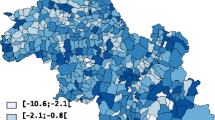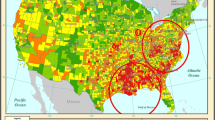Abstract
Objectives
Cancer registries are increasingly mapping residences of patients at time of diagnosis, however, an accepted protocol for spatial analysis of these data is lacking. We undertook a public health practice–research partnership to develop a strategy for detecting spatial clusters of early stage breast cancer using registry data.
Methods
Spatial patterns of early stage breast cancer throughout Michigan were analyzed comparing several scales of spatial support, and different clustering algorithms.
Results
Analyses relying on point data identified spatial clusters not detected using data aggregated into census block groups, census tracts, or legislative districts. Further, using point data, Cuzick-Edwards’ nearest neighbor test identified clusters not detected by the SaTScan spatial scan statistic. Regression and simulation analyses lent credibility to these findings.
Conclusions
In these cluster analyses of early stage breast cancer in Michigan, spatial analyses of point data are more sensitive than analyses relying on data aggregated into polygons, and the Cuzick-Edwards’ test is more sensitive than the SaTScan spatial scan statistic, with acceptable Type I error. Cuzick-Edwards’ test also enables presentation of results in a manner easily communicated to public health practitioners. The approach outlined here should help cancer registries conduct and communicate results of geographic analyses.




Similar content being viewed by others
References
Bell BS, Hoskins RE, Pickle LW, Wartenberg D (2006) Current practices in spatial analysis of cancer data: mapping health statistics to inform policymakers and the public. Int J Health Geogr 5:49. doi:10.1186/1476-072X-5-49
Rushton G, Elmes G, McMaster R (2000) Considerations for improving geographic information system research in public health. URISA J 12:31–49
Alexander FE, Boyle P (eds) (1996) Methods for investigating localized clustering of disease. International Agency for Research on Cancer, Lyon, France
Caldwell GG (1990) Twenty-two years of cancer cluster investigations at the Centers for Disease Control. Am J Epidemiol 132:S43–S47
Warner SC, Aldrich TE (1988) The status of cancer cluster investigations undertaken by state health departments. Am J Public Health 78:306–307
Jacquez GM, Meliker J, Kaufmann A (2007) In search of induction and latency periods: tests for space-time interaction and clustering accounting for residential mobility, known risk factors and covariates. Int J Health Geogr 6:35. doi:10.1186/1476-072X-6-35
Meliker JR, Jacquez GM (2007) Space-time clustering of case-control data with residential histories: Insights into empirical induction periods, age-specific susceptibility, and calendar year-specific effects. Stoch Environ Res Risk Assess 21:625–634. doi:10.1007/s00477-007-0140-3
Sabel CE, Boyle PJ, Loytonen M et al (2003) Spatial clustering of amyotrophic lateral sclerosis in Finland at place of birth and place of death. Am J Epidemiol 157:898–905. doi:10.1093/aje/kwg090
Zurriaga O, Vanaclocha H, Martinez-Beneito MA, Botella-Rocamora P (2008) Spatio-temporal evolution of female lung cancer mortality in a region of Spain, is it worth taking migration into account? BMC Cancer 8:35. doi:10.1186/1471-2407-8-35
McElroy JA, Remington PL, Gangnon RE, Hariharan L, Andersen LD (2006) Identifying geographic disparities in the early detection of breast cancer using a geographic information system. Prev Chronic Dis 3:A10. http://www.cdc.gov/pcd/issues/2006/jan/05_0065.htm
Abe T, Martin IB, Roche LM (2006) Clusters of census tracts with high proportions of men with distant-stage prostate cancer incidence in New Jersey, 1995 to 1999. Am J Prev Med 30:S60–S66. doi:10.1016/j.amepre.2005.09.003
DeChello LM, Sheehan TJ (2007) Spatial analysis of colorectal incidence and proportion of late-stage in Massachusetts residents: 1995–1998. Int J Health Geogr 6:20. doi:10.1186/1476-072X-6-20
MacKinnon JA, Duncan RC, Huang Y et al (2007) Detecting an association between socioeconomic status and late stage breast cancer using spatial analysis and area-based measures. Cancer Epidemiol Biomarkers Prev 16:756–762. doi:10.1158/1055-9965.EPI-06-0392
Klassen AC, Kulldorff M, Curriero F (2005) Geographical clustering of prostate cancer grade and stage at diagnosis, before and after adjustment for risk factors. Int J Health Geogr 5:1. doi:10.1186/1476-072X-4-1
Pollack LA, Gotway CA, Bates JH et al (2006) Use of the spatial scan statistic to identify geographic variations in late stage colorectal cancer in California (United States). Cancer Causes Control 17:449–457. doi:10.1007/s10552-005-0505-1
Rushton G, Peleg I, Banerjee A, Smith G, West M (2004) Analyzing geographic patterns of disease incidence: rates of late-stage colorectal cancer in Iowa. J Med Syst 28:223–236. doi:10.1023/B:JOMS.0000032841.39701.36
Openshaw S, Taylor PJ (1981) The modifiable areal unit problem. In: Wrigley N, Bennett R (eds) Quantitative geography: a British view. Routledge and Kegan Paul, London, UK, pp 60–69
Oden N, Jacquez G, Grimson R (1996) Realistic power simulations compare point- and area-based disease cluster tests. Stat Med 15:783–806. doi:10.1002/(SICI)1097-0258(19960415)15:7/9<783::AID-SIM249>3.0.CO;2-O
Olson KL, Grannis SJ, Mandl KD (2006) Privacy protection versus cluster detection in spatial epidemiology. Am J Public Health 96:2002–2008. doi:10.2105/AJPH.2005.069526
Ozonoff A, Jeffery C, Manjourides J, White LF, Paganao M (2007) Effect of spatial resolution on cluster detection: a simulation study. Int J Health Geogr 6:52. doi:10.1186/1476-072X-6-52
Gregorio DI, DeChello LM, Samociuk H, Kulldorff M (2005) Lumping or splitting: seeking the preferred areal unit for health geography studies. Int J Health Geogr 4:6. doi:10.1186/1476-072X-4-6
Aamodt G, Samuelsen SO, Skrondal A (2006) A simulation study of three methods for detecting disease clusters. Int J Health Geogr 5:15. doi:10.1186/1476-072X-5-15
Jacquez GM, Greiling DA (2003) Local clustering in breast, lung and colorectal cancer in Long Island, New York. Int J Health Geogr 2:3. doi:10.1186/1476-072X-2-3
Kulldorff M, Song C, Gregorio D, Samociuk H, DeChello L (2006) Cancer map patterns: are they random or not? Am J Prev Med 30(2S):S37–S49. doi:10.1016/j.amepre.2005.09.009
Song C, Kulldorff M (2003) Power evaluation of disease clustering tests. Int J Health Geogr 2:9. doi:10.1186/1476-072X-2-9
Fotheringham AS, Zhan FB (1996) A comparison of three exploratory methods for cluster detection in spatial point patterns. Geogr Anal 28:200–218
Ozdenerol E, Williams BL, Kang SY, Magsumbol MS (2005) Comparison of spatial scan statistic and spatial filtering in estimating low birth weight clusters. Int J Health Geog 4:19. doi:10.1186/1476-072X-4-19
Ozonoff A, Webster T, Vieira V, Weinberg J, Ozonoff D, Aschengrau A (2005) Cluster detecting methods applied to the Upper Cape Cod cancer data. Environ Health 4:19. doi:10.1186/1476-069X-4-19
Wheeler DC (2007) A comparison of spatial clustering and cluster detection techniques for childhood leukemia incidence in Ohio, 1996–2003. Int J Health Geogr 6:13. doi:10.1186/1476-072X-6-13
Kulldorff M (1997) A spatial scan statistic. Commun Statist Theory Methods 26:1481–1496. doi:10.1080/03610929708831995
Cuzick J, Edwards R (1996) Clustering methods based on k nearest neighbour distributions. In: Alexander FE, Boyle P (eds) Methods for investigating localized clustering of disease. International Agency for Research on Cancer, Lyon, France, pp 53–67
Surveillance, Epidemiology and End Results Program (1977) Summary Staging Guide for Cancer Surveillance, Epidemiology and End Results Reporting (SEER) Program. NIH Publication No. 86-2313. National Cancer Institute, Bethesda, MD (Reprinted July 1986)
Young JL Jr, Roffers SD, Ries LAG, Fritz AG, Hurlbut AA (eds) (2001) SEER Summary Staging Manual—2000: codes and coding instructions. NIH Publication No. 01-4969, National Cancer Institute, Bethesda, MD
Krieger N, Chen JT, Waterman PD, Rehkopf DH, Subramaniam SV (2003) Race/Ethnicity, and monitoring socioeconomic gradients in health: a comparison of area-based socioeconomic measures—the Public Health Disparities Geocoding Project. Am J Public Health 93:1655–1671
Goovaerts P, Meliker J, Jacquez GM (2007) A comparative analysis of aspatial statistics for detecting racial disparities in cancer mortality rates. Int J Health Geogr 6:32. doi:10.1186/1476-072X-6-32
Wang F, McLafferty S, Escamilla V, Luo L (2008) Late-stage breast cancer diagnosis and health care access in Illinois. Prof Geogr 60:54–69. doi:10.1080/00330120701724087
Kwok RK, Yankaskas BC (2001) The use of census data for determining race and education as SES indicators: a validation study. Ann Epidemiol 11:171–177. doi:10.1016/S1047-2797(00)00205-2
Pickle LW, Szczur M, Lewis DR, Stinchcomb DG (2006) The crossroads of GIS and health information: a workshop on developing a research agenda to improve cancer control. Int J Health Geogr 5:51. doi:10.1186/1476-072X-5-51
Rushton G, Armstrong MP, Gittler J et al (2006) Geocoding in cancer research—a review. Am J Prev Med 30(2S):S16–S24. doi:10.1016/j.amepre.2005.09.011
Boscoe FP, Miller BA (2004) Population estimation error and its impact on 1991–1999 cancer rates. Prof Geogr 56:516–529
Freedman D, Wachter K (1994) Heterogeneity and census adjustment for the intercensal base. Stat Sci 9:476–485
Kennedy S (1989) The small number problem and the accuracy of spatial databases. In: Goodchild M, Gopal S (eds) Accuracy of spatial databases. Taylor & Francis Ltd, London, UK, pp 187–196
Prehn AW, Clarke C, Topol B, Glaser S, West D (2002) Increase in breast cancer incidence in middle-aged women during the 1990s. Ann Epidemiol 12:476–481. doi:10.1016/S1047-2797(01)00315-5
Ward E, Jemal A, Thun MJ (2005) Increase in breast cancer incidence in middle aged women during the 1990s. Ann Epidemiol 15:424–425. doi:10.1016/j.annepidem.2004.09.008
Acknowledgments
This research was supported in part by CDC Grant 5U58DP000812 and by NCI Grants 1R43CA112743, 1R43CA132347, and 1R43CA135818. The perspectives are those of the authors and do not necessarily represent the official position of the funding agencies.
Author information
Authors and Affiliations
Corresponding author
Rights and permissions
About this article
Cite this article
Meliker, J.R., Jacquez, G.M., Goovaerts, P. et al. Spatial cluster analysis of early stage breast cancer: a method for public health practice using cancer registry data. Cancer Causes Control 20, 1061–1069 (2009). https://doi.org/10.1007/s10552-009-9312-4
Received:
Accepted:
Published:
Issue Date:
DOI: https://doi.org/10.1007/s10552-009-9312-4




